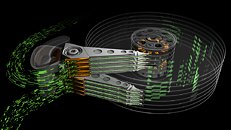
Seagate Bringing RAID 0 Performance to Single HDD via Multi-Actuator Tech
Seagate may currently be one of the first tech companies in storage conversations due to their upcoming HAMR (Heat-Assisted Magnetic Recording) technology, which should enable 20 TB HDDs by 2020. And even though HDDs are better known for their high areal density and price/storage ratio, which is only bound to increase through the usage of HAMR, Seagate knows that areal density is hardly one of the principal bottlenecks in HDD technology. The bottleneck, as it usually is, is speed.
HDDs have an old design philosophy by now, where an actuator arm moves read/writing heads in parallel across the surface of the disk - nowadays, there are usually two heads per platter (one on the upper side, and one on the underside of it). As you might image, a given head can either read or write at one point in time - and all heads move in tandem, with different heads reading or writing across the multiple spinning discs that constitute the hard drive. This, however, means that HDD reading efficiency is lost - due to how small the 1s and 0s are on HDDs, only one head can be moved to an exact data path, with all the others moving with it, spending power and increasing the load on the actuator for nary a speed gain or minimal workload.
HDDs have an old design philosophy by now, where an actuator arm moves read/writing heads in parallel across the surface of the disk - nowadays, there are usually two heads per platter (one on the upper side, and one on the underside of it). As you might image, a given head can either read or write at one point in time - and all heads move in tandem, with different heads reading or writing across the multiple spinning discs that constitute the hard drive. This, however, means that HDD reading efficiency is lost - due to how small the 1s and 0s are on HDDs, only one head can be moved to an exact data path, with all the others moving with it, spending power and increasing the load on the actuator for nary a speed gain or minimal workload.
